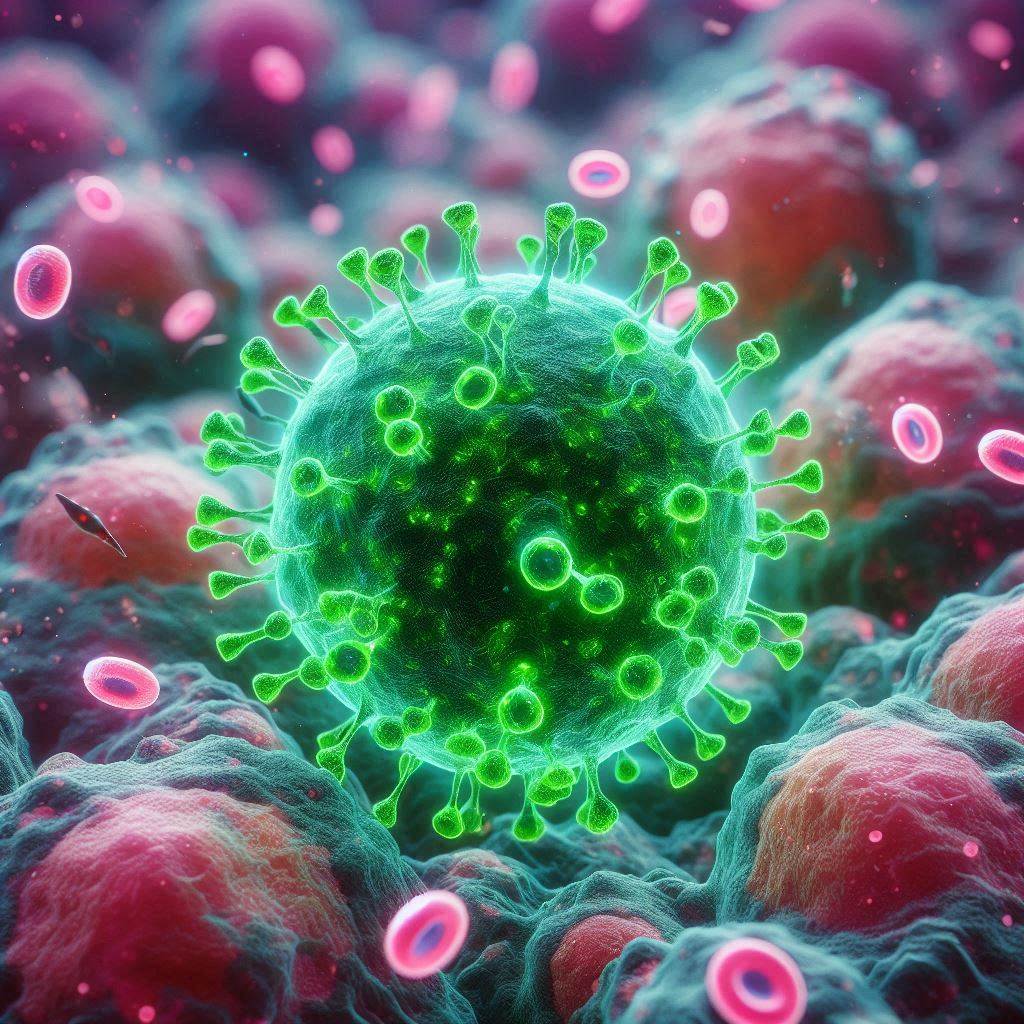Cancer remains one of the leading causes of death worldwide, with approximately 9.6 million fatalities recorded in recent years. Traditional treatments like chemotherapy, radiation, and surgery, while effective to some extent, often come with severe side effects and limitations. Enter oncolytic virotherapy—a groundbreaking approach that leverages genetically modified viruses to target and destroy cancer cells while sparing healthy tissue.
This novel therapy not only aims to improve the efficacy of cancer treatment but also to reduce the adverse effects associated with conventional methods. As research and clinical trials advance, oncolytic virotherapy is poised to become a pivotal player in the fight against cancer, offering new hope to millions of patients globally.
What is Oncolytic Virotherapy?
Oncolytic virotherapy is an innovative cancer treatment that uses genetically engineered viruses to selectively infect and kill cancer cells. Unlike traditional therapies, which can harm healthy tissues, oncolytic virotherapy targets only cancerous cells. The engineered viruses replicate within these cells, causing them to burst and die.
Additionally, the process stimulates the body’s immune response to recognize and attack remaining cancer cells. This dual mechanism enhances the efficacy of treatment while minimizing damage to normal tissues, offering a promising new approach to cancer therapy.
Read: Supplement Use And Increased Risks Of Cancer
How Does Oncolytic Virotherapy Work?
The mechanism of action of oncolytic virotherapy involves several key steps, each contributing to its effectiveness in targeting and destroying cancer cells while sparing healthy tissues:
Selective Infection
Oncolytic viruses are genetically engineered to preferentially infect cancer cells. This selectivity is achieved through modifications that exploit the unique characteristics of cancer cells, such as specific surface receptors or the altered metabolic environment within tumors.
Viral Replication
Once inside the cancer cell, the virus begins to replicate. Cancer cells, due to their compromised antiviral defenses, are unable to effectively inhibit this replication. As the virus multiplies, it uses the cellular machinery of the cancer cell, eventually overwhelming the cell’s capacity to function.
Cell Lysis
The rapid replication of the virus within the cancer cell leads to the cell bursting, or lysing. This lysis releases a large number of newly created viral particles into the surrounding tissue, where they can infect neighboring cancer cells.
Immune System Activation
The destruction of cancer cells by oncolytic viruses also releases tumor-associated antigens, which are proteins specific to cancer cells. These antigens alert the immune system to the presence of the cancer. The immune system, recognizing these antigens as foreign, mounts a targeted response against the remaining cancer cells, enhancing the overall anticancer effect.
Indirect Antitumor Effects
Beyond direct cell lysis and immune activation, oncolytic virotherapy can modulate the tumor microenvironment to make it less conducive to cancer growth and spread. This includes disrupting the blood supply to tumors and altering the surrounding stroma to inhibit cancer cell migration and invasion.
Combination Therapy Potential
Oncolytic viruses can be engineered to express therapeutic genes, such as those encoding immune-stimulating cytokines or other anticancer agents. This further enhances their ability to attack cancer through multiple mechanisms.
The action of oncolytic virotherapy is a multifaceted process that combines direct destruction of cancer cells through viral replication and cell lysis, with indirect antitumor effects mediated by the immune system. This dual approach not only targets the primary tumor but also helps to prevent metastasis and recurrence, making oncolytic virotherapy a powerful tool in the fight against cancer.
Common Oncolytic Viruses in Use

Here are the oncolytic viruses that are in use in oncolytic virotherapy.
Herpes Simplex Virus (HSV)
HSV has been modified to target and destroy cancer cells, with Talimogene laherparepvec (T-VEC) being a notable example. T-VEC is approved for treating advanced melanoma and works by both directly killing cancer cells and stimulating an immune response.
Adenovirus
Adenoviruses are often used due to their ability to infect a wide range of cell types. H101 and Oncorine are examples of adenovirus-based oncolytic therapies used in clinical settings, particularly in China for treating certain types of cancer.
Reovirus
Reovirus preferentially infects cancer cells with activated Ras pathways, which are common in many tumors. Clinical trials have shown promising results in using reovirus as an oncolytic agent.
Vaccinia Virus
Known for its role in smallpox vaccination, the vaccinia virus is also being explored for its oncolytic properties. Its large genome allows for multiple genetic modifications, making it a versatile tool in cancer therapy.
Others
Other viruses being investigated include the Newcastle disease virus, measles virus, and vesicular stomatitis virus, each offering unique mechanisms and advantages for targeting cancer.
Is Oncolytic Virotherapy Proven Effective In Treating Cancer?
Yes, oncolytic virotherapy has shown promising efficacy in treating cancer, as demonstrated by preclinical studies and clinical trials across various cancer types. While it may not yet be considered a standalone cure for cancer, it has exhibited significant potential as part of comprehensive treatment strategies.
Several oncolytic viruses have been studied extensively in both laboratory settings and clinical trials. Examples include genetically modified herpes simplex virus (HSV), adenovirus, and vaccinia virus, among others. These viruses have been engineered to selectively target and replicate within cancer cells while sparing healthy tissues.
Clinical trials investigating oncolytic virotherapy have reported encouraging outcomes, including tumor shrinkage, disease stabilization, and, in some cases, complete remission in patients with advanced or refractory cancers. Moreover, the therapeutic effects of oncolytic virotherapy can be enhanced when combined with other treatment modalities, such as chemotherapy, radiation therapy, or immunotherapy.
While challenges remain, such as optimizing delivery methods, minimizing potential side effects, and improving the specificity of viral targeting, the accumulating evidence suggests that oncolytic virotherapy holds great promise as a valuable addition to the armamentarium of cancer treatments. Continued research and clinical development are necessary to fully realize its potential and establish its role in standard cancer care protocols.
Comparison Of Oncolytic Virotherapy with Traditional Cancer Treatments
Comparing oncolytic virotherapy with traditional cancer treatments highlights both similarities and differences in their approaches, efficacy, and side effect profiles:
Mechanism of Action
Traditional cancer treatments like chemotherapy and radiation therapy work by targeting rapidly dividing cells, which includes both cancerous and healthy cells. In contrast, oncolytic virotherapy specifically targets cancer cells while sparing normal tissues, primarily through the selective replication of engineered viruses within tumor cells.
Efficacy
Traditional treatments can be effective in killing cancer cells and reducing tumor size, but they often come with significant side effects due to their non-selective nature. Oncolytic virotherapy, while still under investigation, has shown promising efficacy in clinical trials, with some patients experiencing tumor regression and even complete remission. Moreover, oncolytic virotherapy can stimulate the immune system to recognize and attack cancer cells, potentially providing long-term benefits beyond direct tumor destruction.
Side Effects
Chemotherapy and radiation therapy commonly cause side effects such as nausea, fatigue, hair loss, and damage to healthy tissues. In contrast, oncolytic virotherapy typically has milder side effects, such as flu-like symptoms or localized inflammation at the injection site. However, there may be risks associated with immune responses to the viral vectors used in oncolytic virotherapy, as well as potential for systemic dissemination of the virus.
Treatment Regimens
Traditional cancer treatments often involve multiple cycles of therapy over a period of weeks to months, depending on the type and stage of cancer. Oncolytic virotherapy may also require multiple administrations, but the frequency and duration of treatment can vary depending on the specific protocol and patient response.
Combination Therapies
Both traditional treatments and oncolytic virotherapy can be used alone or in combination with other therapies to enhance efficacy. For example, oncolytic virotherapy may be combined with chemotherapy, radiation therapy, or immunotherapy to achieve synergistic effects and improve outcomes.
Overall, while traditional cancer treatments remain essential components of cancer care, oncolytic virotherapy represents a promising new approach with the potential to improve treatment outcomes and quality of life for cancer patients. Continued research and clinical trials are needed to further refine and optimize the use of oncolytic virotherapy in combination with existing therapies.
Ethical and Regulatory Considerations About Oncolytic Virotherapy

The development and implementation of oncolytic virotherapy raise several ethical and regulatory considerations that warrant careful attention:
Safety
Ensuring the safety of patients undergoing oncolytic virotherapy is paramount. Researchers and regulatory bodies must conduct rigorous preclinical studies to assess the potential risks associated with the use of genetically modified viruses, including the possibility of unintended side effects or systemic spread of the virus. Clinical trials must adhere to strict safety protocols to minimize harm to participants.
Informed Consent
Patients considering participation in clinical trials of oncolytic virotherapy must be fully informed about the experimental nature of the treatment, potential risks and benefits, and alternative treatment options. Informed consent processes should be transparent and comprehensive, providing patients with the information they need to make autonomous decisions about their participation.
Equitable Access
Ensuring equitable access to oncolytic virotherapy is essential to prevent disparities in cancer care. Regulatory frameworks should address issues of affordability, reimbursement, and availability of treatment, particularly for underserved populations who may face barriers to accessing novel therapies.
Genetic Engineering
The genetic modification of viruses for use in oncolytic virotherapy raises ethical questions about the manipulation of living organisms and the potential for unintended consequences. Ethical considerations include the need for responsible stewardship of genetic technologies, consideration of environmental impacts, and safeguards against misuse or bioterrorism.
Benefit-Risk Assessment
Ethical decision-making regarding the approval and regulation of oncolytic virotherapy requires careful consideration of the balance between potential benefits and risks. Regulatory agencies must weigh the potential therapeutic benefits of oncolytic virotherapy against the potential risks to patient safety, public health, and the environment.
Regulatory Oversight
Robust regulatory oversight is essential to ensure the safety, efficacy, and quality of oncolytic virotherapy products. Regulatory agencies, such as the Food and Drug Administration (FDA) in the United States and the European Medicines Agency (EMA) in Europe, play a crucial role in evaluating the scientific evidence, assessing risks and benefits, and approving or authorizing the use of oncolytic virotherapy products for clinical use.
Read: Effective Semaglutide Effects On CKD In Patients With Type 2 Diabetes
Conclusion
Oncolytic virotherapy represents a groundbreaking approach to cancer treatment, offering a targeted, effective, and potentially less harmful alternative to traditional methods. While challenges remain, ongoing research and development are paving the way for more widespread use and improved patient outcomes. The future of cancer treatment looks promising with the continued advancement of oncolytic virotherapy
